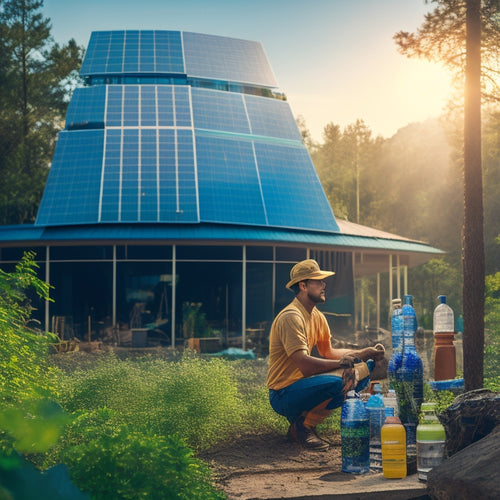
7 Household Carbon Offset Strategies for Eco-Conscious Homeowners
Share
As an eco-conscious homeowner, you're likely aware that your household energy consumption accounts for approximately 30% of your carbon footprint, which is why implementing effective carbon offset strategies is essential to reducing your environmental impact. You can start by investing in renewable energy sources like solar or wind power, or purchasing renewable energy certificates to support clean energy projects. Energy-efficient home upgrades, such as smart thermostats and insulation, can also greatly reduce your energy waste. Additionally, practices like carbon offsetting for home energy, sustainable living, tree planting, and reforestation can further minimize your carbon footprint. By adopting these strategies, you'll be well on your way to creating a more sustainable future - and there's even more you can do to make a meaningful difference.
Key Takeaways
- Invest in Renewable Energy Certificates (RECs) to support renewable energy project development and offset carbon emissions.
- Conduct an energy audit to identify areas for energy efficiency upgrades, reducing energy waste and household carbon footprint.
- Explore carbon offset programs that support reforestation and renewable energy projects to counterbalance home energy consumption.
- Implement sustainable living practices like reducing, reusing, and recycling to minimize waste and lower carbon footprint.
- Consider tree planting and reforestation efforts, choosing native species that thrive in local climate and soil conditions for efficient growth.
Renewable Energy Certificates
When it comes to reducing your household's carbon footprint, Renewable Energy Certificates (RECs) can be an important tool in your arsenal. RECs represent the environmental attributes of one megawatt-hour of renewable energy, such as wind or solar power. By purchasing RECs, you're supporting the development of renewable energy projects and offsetting your carbon emissions.
In carbon trading, RECs are bought and sold, allowing individuals and organizations to compensate for their greenhouse gas emissions. Additionally, RECs provide a reliable mechanism for carbon footprint neutralization, ensuring that renewable energy is verifiably sustainable.
They also promote grid resilience and optimize energy storage, reducing reliance on fossil fuels. By investing in RECs, you're promoting a cleaner, more sustainable energy future and taking an important step towards reducing your household's reliance on fossil fuels.
With RECs, you can make a tangible impact on the environment while enjoying the freedom to live more sustainably.
Carbon Offset for Home Energy
You're likely aware that your home energy use is a significant contributor to your carbon footprint. To offset this impact, you can implement energy efficiency upgrades, such as sealing air leaks and upgrading to energy-efficient appliances.
Additionally, you can investigate renewable energy sources, like solar or geothermal power, and carbon neutral fuels, like biodiesel or ethanol, to further reduce your emissions. By adopting renewable energy, you can reduce greenhouse gas emissions, contributing to a more sustainable future renewable energy solutions, and even save up to 70% on annual fuel costs, which can enhance your return on investment.
Energy Efficiency Upgrades
About 30% of the average American's carbon footprint stems from home energy consumption, making energy efficiency upgrades an essential step in offsetting your household's carbon impact.
You can start by conducting an energy audit to identify areas of improvement. This will help you pinpoint where energy is being wasted and prioritize upgrades.
Consider installing smart thermostats, which can learn your schedule and preferences to optimize heating and cooling. Additionally, look into upgrading to energy-efficient appliances, insulation, and windows.
Moreover, incorporating solar-powered fast charging hubs and renewable energy sources can greatly reduce your carbon footprint.
Renewable Energy Sources
Two-thirds of US electricity generation still relies on fossil fuels, making a switch to renewable energy sources essential for minimizing your household's carbon footprint. You can greatly reduce your reliance on fossil fuels by investing in renewable energy sources.
| Renewable Energy Source | Benefits | Considerations |
| Solar Panels | Zero emissions, lower electricity bills | Initial installation cost, space requirements |
| Wind Turbines | Renewable energy, reduced carbon footprint | Noise, visual impact, installation cost |
| Geothermal Energy | Reliable, consistent heat source | High upfront cost, limited availability |
| Biomass Energy | Renewable, carbon neutral | Space requirements, fuel sourcing |
| Hydro Energy | Renewable, low maintenance | Location dependent, high upfront cost |
Carbon Neutral Fuels
As you shift to renewable energy sources, another essential step in minimizing your household's carbon footprint is to examine carbon neutral fuels for home energy.
You can investigate biofuel options, such as biodiesel or ethanol, which are produced from organic matter like plants and waste. These fuels can reduce greenhouse gas emissions by up to 80% compared to traditional fossil fuels. The transportation sector, which accounts for 23% of total emissions, can greatly benefit from such alternatives reducing carbon footprint.
Furthermore, adopting sustainable practices is essential for combating climate change and mitigating biodiversity loss. Synthetic fuels, like power-to-x (P2X), are another option. They're created by converting renewable energy into a fuel that can be used in existing infrastructure.
Sustainable Living Practices
By incorporating sustainable living practices into your daily routine, you can considerably reduce your household's carbon footprint. You can start by adopting a zero-waste lifestyle, which involves reducing, reusing, and recycling waste. This can be achieved by avoiding single-use plastics, buying in bulk, and composting food waste. Additionally, sustainable gardening practices like using rainwater, compost, and natural pest control methods can also help reduce your carbon footprint.
| Sustainable Living Practices | Benefits |
|---|---|
| Reduce, Reuse, Recycle | Reduces waste sent to landfills |
| Sustainable Gardening | Reduces chemical use and conserves water |
| Buy in Bulk | Reduces packaging waste and saves money |
Energy-Efficient Home Upgrades
You can take your household's carbon offset strategy to the next level by investing in energy-efficient home upgrades.
These upgrades not only reduce your energy consumption but also save you money on your utility bills. By incorporating high-efficiency solar panels with conversion rates up to 23% smart charging station design, you can optimize your energy yield and reduce your reliance on the grid.
Start by conducting an energy audit to identify areas of inefficiency in your home. This will help you pinpoint where to focus your upgrade efforts.
Consider installing smart thermostats, which can learn your schedule and preferences to optimize heating and cooling. You can also upgrade to energy-efficient appliances, insulation, and windows.
Tree Planting and Reforestation
By planting trees and supporting reforestation efforts, you're investing in one of the most effective carbon sequestration methods available.
When selecting tree species, it's crucial to choose native varieties that thrive in local conditions, ensuring a healthier and more resilient forest ecosystem.
As you investigate forest preservation efforts, you'll want to reflect on the long-term sustainability of these initiatives and their potential to make a meaningful impact on your household's carbon footprint.
Carbon Sequestration Methods
Carbon sequestration methods, including tree planting and reforestation, offer a powerful tool in the fight against climate change. By adopting these strategies, you can effectively remove CO2 from the atmosphere, mitigate climate change, and promote ecological balance. When implementing tree planting and reforestation efforts, consider the following factors to maximize carbon sequestration:
| Factor | Description |
|---|---|
| Soil Management | Proper soil management practices enhance tree growth, increasing carbon sequestration potential. |
| Agroforestry Practices | Integrating trees into agricultural environments promotes biodiversity and carbon sequestration. |
| Species Selection | Choosing species with high carbon sequestration potential maximizes results. |
| Site Preparation | Proper site preparation guarantees ideal tree growth and carbon sequestration. |
| Ongoing Maintenance | Regular maintenance, such as pruning and thinning, sustains carbon sequestration over time. |
Native Species Selection
What makes a tree species a suitable choice for carbon sequestration efforts in a particular region?
You'll want to choose native species that thrive in your local climate and soil conditions. This guarantees they'll grow quickly and efficiently, maximizing carbon sequestration.
Native species also provide a natural habitat for local wildlife, enhancing biodiversity.
Consider creating native plant gardens that incorporate multiple tree species, as well as shrubs and flowers. This approach not only supports carbon sequestration but also biodiversity enhancement.
Forest Preservation Efforts
While establishing native plant gardens is a great way to support local ecosystems, you can further amplify your carbon offset efforts by focusing on forest preservation. Tree planting and reforestation are essential strategies in forest management, as they help to remove CO2 from the atmosphere and store it in trees and soil. This approach also supports biodiversity conservation by providing habitats for various species.
| Forest Type | Carbon Sequestration | Biodiversity Benefits |
|---|---|---|
| Tropical Rainforest | High | High |
| Temperate Forest | Medium | Medium |
| Boreal Forest | Low | Low |
Green Commuting Incentives
Through innovative programs and policies, governments and companies are motivating individuals to adopt eco-friendly transportation methods, greatly reducing the carbon footprint of daily commutes.
You can take advantage of these incentives to make a notable impact. For instance, many cities offer bike sharing programs, allowing you to rent a bike for a day or by the hour. This mode of transportation isn't only environmentally friendly but also cost-effective and convenient.
Additionally, some employers and local governments provide public transportation subsidies, making it more affordable for you to use buses, trains, or subways.
Offsetting Home Energy Consumption
You can greatly reduce your household's carbon footprint by offsetting home energy consumption. By investing in renewable energy sources like solar or wind power, you can counterbalance the carbon emissions from your energy usage.
Consider upgrading to a smart home system, which allows for real-time energy monitoring and optimization. This enables you to identify areas of inefficiency and make adjustments to minimize waste.
Additionally, look into carbon offset programs that invest in projects like reforestation, renewable energy, or energy efficiency initiatives.
Frequently Asked Questions
Can I Offset Carbon Emissions From My Home Office or Workspace?
You can offset carbon emissions from your home office by investing in energy efficiency upgrades, sustainable practices, and renewable energy sources, reducing your workspace's carbon footprint and contributing to a more eco-friendly future.
How Do I Calculate My Household's Carbon Footprint Accurately?
Did you know 22% of global emissions come from households? To calculate your carbon footprint accurately, you'll need reliable measurement tools. Employ online carbon calculators, like the EPA's Household Carbon Footprint Calculator, to get a precise measurement and start making eco-friendly changes.
Are Carbon Offset Credits Transferable Between Homes or Owners?
When you buy carbon offset credits, you're wondering if they're transferable between homes or owners. The good news is that most credits are portable, allowing you to transfer ownership and credit portability to a new home or owner.
Can I Combine Multiple Offset Strategies for Greater Impact?
You can create a powerful carbon-reducing portfolio by combining multiple offset strategies, leveraging synergistic effects to amplify your impact, and maximizing your eco-friendly efforts through diversified investments that work together seamlessly.
Are There Tax Benefits or Incentives for Household Carbon Offsetting?
When offsetting carbon emissions, you'll be pleased to know that you may be eligible for tax deductions or incentives through government-backed programs, which can help offset the costs of your eco-friendly efforts, giving you more freedom to live sustainably.
Related Posts
-

What Tax Deductions Apply to Sustainable Building Materials?
You can claim various tax deductions for sustainable building materials, thanks to over 40 federal tax incentives sup...
-

Why EVs Inspire Earth-Conscious Home Design Choices
As you shift to an electric vehicle, you're not just switching to a greener ride, you're igniting a broader commitmen...
-

Why Choose Solar Composting Toilets for Your Home?
By choosing a solar composting toilet for your home, you'll greatly reduce your environmental impact, slashing your w...


